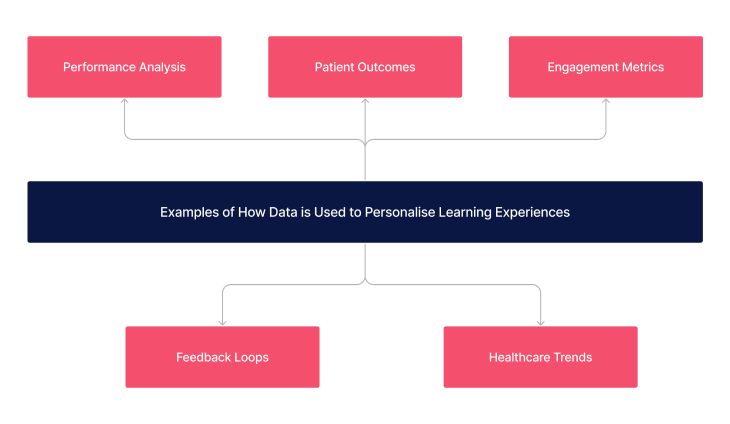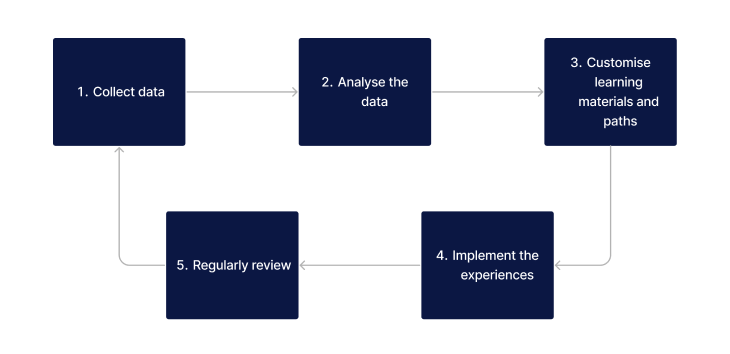What is a Learning Experience?
A learning experience in healthcare encompasses the acquisition of knowledge, skills, and competencies by health professionals. This spans from care worker training to specialised medical education, focusing on enhancing the quality of health services and public health outcomes.
What is a Personalised Learning Experience?
Personalised learning tailors educational experiences to individual learner's needs, preferences, and health conditions. In healthcare, this means adapting learning modules for diverse roles such as support workers, healthcare professionals, and health insurance advisors to better address the intricacies of the health system.
What are Personalised Learning Experiences in Healthcare?
In healthcare, personalised learning experiences involve curating content relevant to specific roles within the sector, such as care services, primary care, and healthcare system management. This ensures that each healthcare professional's learning is directly applicable to their field of work.
Examples of How Data is Used to Personalise Learning Experiences

Understanding the various ways data is employed to tailor learning experiences is crucial. Below are detailed examples showcasing the practical application of data in personalising healthcare education:
- Performance Analysis: Evaluating care workers' training results to identify areas needing more focus or different approaches.
- Patient Outcomes: Leveraging data from patient care to develop targeted training for healthcare professionals, enhancing patient care quality.
- Engagement Metrics: Using data from learning modules to see which sections engage learners most, helping refine and focus the curriculum.
- Feedback Loops: Incorporating feedback from health workers to continuously adapt and improve training content.
- Healthcare Trends: Analysing current healthcare trends and updating training modules to keep healthcare professionals up-to-date with the latest practices.
How to Use Data to Personalise Learning Experiences
Data-driven personalisation in learning involves utilising types of data like performance metrics, health conditions prevalence, and learning progress to adapt educational content for a more impactful learning experience.
Strategies to Use Data to Personalise Learning Experiences
Strategically utilising data is key to personalising learning experiences effectively. Here are some strategies that can be implemented:
- Establishing clear objectives for what the learning experience should achieve, based on health sector needs.
- Integrating data analytics into learning platforms for real-time feedback and adaptation.
- Creating adaptive learning paths that change based on the learner's progress and performance.
- Regularly reviewing and updating educational content based on the latest health data and research findings.
- Developing a feedback system where learners can contribute their experiences and suggestions.
Steps to Use Data to Personalise Learning Experiences

Implementing a data-driven approach to personalise learning experiences involves several key steps. Here they are laid out in a sequential manner:
- Collect relevant data, including learner performance, engagement levels, and feedback.
- Analyse the data to identify trends, strengths, and areas for improvement.
- Customise learning materials and paths based on the insights gained from the data analysis.
- Implement the personalised learning experiences and continue to collect data for ongoing refinement.
- Regularly review and adjust the learning approach based on evolving data and learner feedback.
Tips for Using Data to Personalise Learning Experiences
To effectively use data in personalising learning experiences, certain best practices should be followed. These tips can guide the process:
- Ensure data privacy and confidentiality, especially when dealing with sensitive health information.
- Maintain a balance between data-driven decisions and the human element in learning.
- Stay updated with the latest data analytics tools and techniques for more accurate insights.
- Involve learners in the data collection process, making them active participants in their education.
- Regularly review and update the data sources and methods to ensure they remain relevant and effective.
Types of Data to Personalise Learning Experiences
Different types of data can be leveraged to create a more personalised learning experience. Here are the key data types utilised in the healthcare education sector:
- Learner Performance Data: Test scores, assignment completions, and skill assessments.
- Engagement Data: Time spent on learning modules, interaction rates, and participation levels.
- Feedback Data: Surveys, reviews, and direct feedback from learners.
- Healthcare Outcomes Data: Patient care outcomes, treatment efficacy, and healthcare service usage.
- Demographic Data: Age, professional background, and specialised fields of learners to tailor content.
Want a healthcare LMS that can uses data to personalise your staff's learning experiences?
Contact Ausmed today and see how we can support your organisation!
Pros and Cons of Using Data to Personalise Learning Experiences
| Pros | Cons |
|---|---|
| Increased relevance and effectiveness of learning material. | Data privacy and security concerns. |
| Improved learner engagement and satisfaction. | Potential for data misinterpretation or bias. |
| Adaptability to individual learner's pace and style. | Need for continuous data monitoring and updating. |
| Better alignment with current healthcare practices and needs. | Resource-intensive in terms of technology and expertise. |
Tools to Personalise Learning Experiences
The right tools are essential for effectively personalising learning experiences using data. Here are some key tools used in the healthcare education sector:
- Learning Management Systems (LMS): Platforms that can integrate data analytics to track and adapt learning paths.
- Data Analytics Software: Tools that help in analysing learner data to gain insights for personalisation.
- Interactive E-Learning Platforms: Platforms that offer dynamic content and adapt to learner interactions.
- Feedback and Survey Tools: For collecting and analysing learner feedback and preferences.
- Customisable Content Libraries: Resources that can be tailored to meet specific learning needs and trends.
Related Resources
- LMS in Healthcare: The Roles, Benefits and Pros and Cons
- What Are Learning Analytics?
- What Are the Key Learning Analytics Metrics?
- A Step-by-Step Guide to Data Collection for Learning Analytics
- How to Use 'Nudge Theory' to Encourage Completion of Outstanding Learning
- How to Create a Culture of Continuous Learning
- How to Manage an Effective Staff Training Program
- Identifying Skills Gaps with Learning Analytics
- How Can I Implement Self-Directed Learning Strategies?
- How Can Organisations Create a Learning Culture that Attracts Amazing People?
- Research Spotlight: Motivation for Self-directed Training
Conclusion
Personalising learning experiences through data in healthcare not only enhances the professional development of health workers but also contributes significantly to the efficacy of the health system. By embracing data-driven personalisation strategies, learning and development managers can ensure that the training provided is impactful, relevant, and tailored to the evolving needs of the healthcare sector.
References
- BMC Health Services Research. (2021). 'Learning health systems using data to drive healthcare improvement and impact: a systematic review'. Available at: https://bmchealthservres.biomedcentral.com/articles/10.1186/s12913-021-06168-4
- Journal of AHIMA. (2023). 'Using Data Analytics to Predict Outcomes in Healthcare'. Available at: https://journal.ahima.org/using-data-analytics-to-predict-outcomes-in-healthcare/
- Raintree. (2022). '4 Ways to Use Data to Create Personalized Healthcare Experiences'. Available at: https://www.raintreeinc.com/blog/4-ways-to-use-data-to-create-personalized-healthcare-experiences
- Appnovation. (2023). 'Make it personal: How health companies can use data to create personalized experiences'. Available at: https://www.appnovation.com/blog/make-it-personal-how-health-companies-can-use-data-create-personalized-experiences
- Caltech. (2023). 'Industry Spotlight: Data Analytics in Healthcare'. Available at: https://pg-p.ctme.caltech.edu/blog/industry-spotlight-data-analytics-in-healthcare



